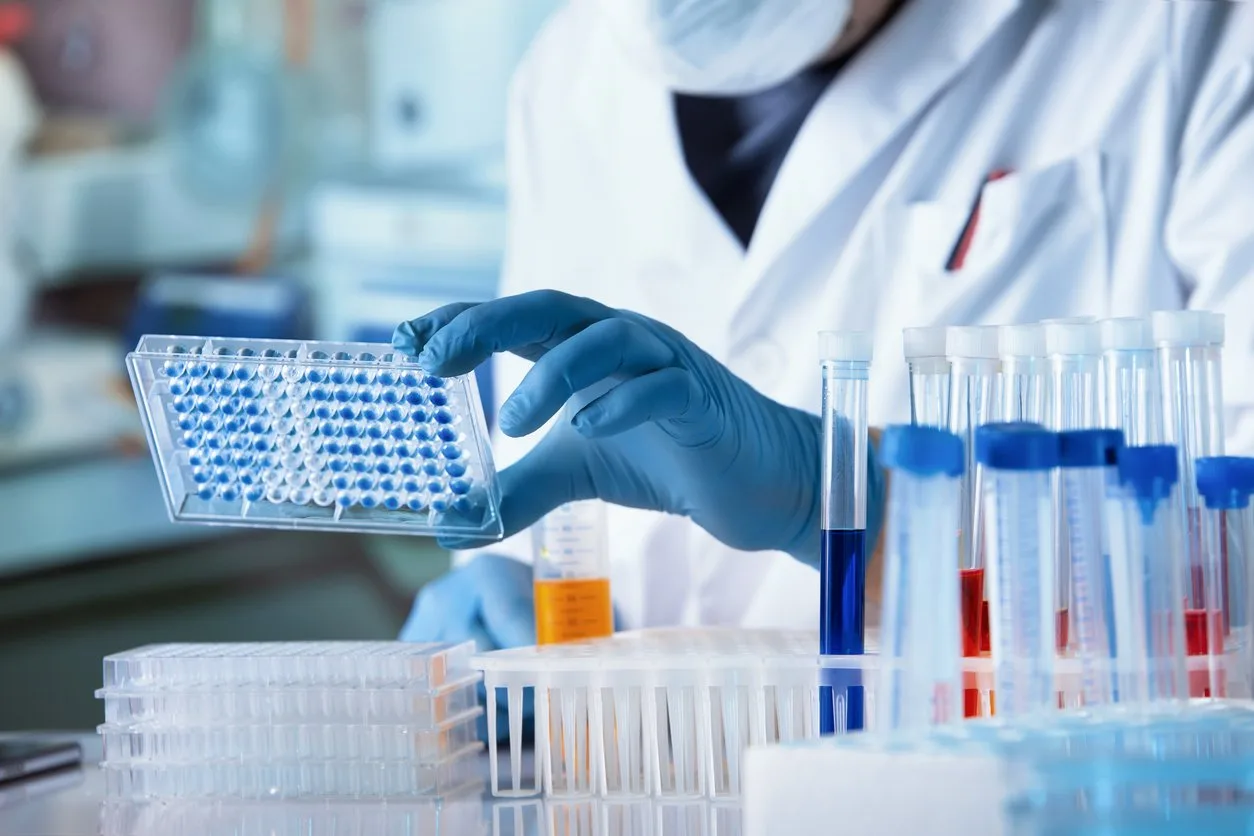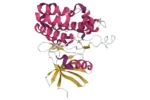BPC-157, also known as L 14736, PL-10, and bepecin, is a much shorter peptide comprising 15 amino acids. This pentadecapeptide is fully synthetic, but its structure is derived from the biologically active sequence of another peptide naturally found in gastric juices. BPC-157 may be associated with various cellular processes and is believed to play a role in tissue repair. It is thought to interact with signaling pathways within cells, potentially influencing factors involved in regeneration and recovery. Some studies suggest that BPC-157 may also have the ability to promote angiogenesis and modulate inflammatory processes.[2] Additionally, it has been suggested by experimental models that BPC-157 might contribute to the protection and regeneration of different cells and tissues.
BPC-157 & TB-500 Blend Mechanisms of Action
BPC-157 & TB-500 appear to have different mechanisms, despite their similar potential. For example, TB-500 (Tβ4) appears to regulate the cellular actin-cytoskeleton and cellular migration by sequestering G-actin.[3] [4] Furthermore, studies suggest that there appears to be a specific signaling pathway involved with damaged tissues that TB-500 may regulate. For instance, researchers have conducted experiments using cell models and observed that TB-500 potentially increases the expression of microRNA-146a (miR-146a), which might be a negative regulator of specific signaling pathways in cells. It appeared that this resulted in TB-500 possibly decreasing the expression of two proinflammatory cytokines associated with the aforementioned signaling pathways – L-1 receptor-associated kinase 1 (IRAK1) and tumor necrosis factor receptor-associated factor 6 (TRAF6). As a further suggestion that the increased expression of miR-146a may be TB-500’s main mechanism of action, the researchers commented that “transfection of anti-miR-146a nucleotides reversed the inhibitory effect of Tβ4 on IRAK1 and TRAF6.“[5]
On the other hand, BPC-157 appears to exert its actions via multiple mechanisms, which may include nitric oxide synthesis, regulating cells involved in tissue repair, growth factors, and inflammation. There is a possibility that BPC-157 interacts with the NO system, potentially offering protection to the endothelium and possibly inducing angiogenic action by promoting the formation of new blood vessels.[6] It may have the potential to stimulate the expression of the early growth response 1 gene, which might be responsible for generating cytokines and growth factors, and perhaps facilitating the early formation of the extracellular matrix, including collagen. It should be noted that BPC-157’s interaction with nerve growth factor 1-A binding protein-2 might have repressive effects on certain factors. However, further research is needed to fully understand and confirm these potential mechanisms of BPC-157.
BPC-157 & TB-500 Blend and the Musculoskeletal System
The BPC-157 & TB-500 appear to both have the potential for speeding up the regeneration of connective tissue, such as the one found in tendons and ligaments. In one murine study, TB-500 was investigated for its potential on ligament recovery and regeneration.[7] The scientists performed histological analysis to compare TB-500 against a placebo in a model of ligament injury. They commended that TB-500 may have induced the formation of a more uniform and evenly spaced bundles of collagen fibers within the granulation tissue that also have larger diameters compared to the control. Furthermore, the mechanical properties of the regenerating tissues, including the femur-medial collateral ligament-tibia complexes, appeared to be improved in the TB-500 group compared to the control.
Another study explored the potential impact of BPC 157 on the outgrowth of tendon fibroblasts from cultured tendon explants.[8] The findings suggested that BPC 157 possibly enhanced the outgrowth of tendon explants. BPC 157 potentially increased the survival of these cells under H(2)O(2) stress. Furthermore, the researchers commented that “BPC 157 markedly increased the in vitro migration of tendon fibroblasts in a dose-dependent manner as revealed by transwell filter migration assay. BPC 157 also dose-dependently accelerated the spreading of tendon fibroblasts on culture dishes.” This effect was potentially associated with the induction of F-actin formation, as evidenced by FITC-phalloidin staining. The study also investigated the potential involvement of the FAK-paxillin (two focal adhesion–associated proteins that transmit signals downstream of integrins) pathway in mediating the potential of BPC 157. Western blot analysis suggested that the phosphorylation levels of both FAK and paxillin were apparently increased by BPC 157, while the total amounts of protein remained unchanged.
Conclusion
In summary, the BPC-157 & TB-500 blend shows a synergistic research potential. TB-500 may be involved in regulating cell migration, differentiation, and repair, potentially promoting angiogenesis and connective tissue regeneration. Furthermore, BPC-157 is also believed to have a potential in cellular repair, possibly by influencing factors involved in the normal recovery process. These peptides appear to have different mechanisms of action, with TB-500 possibly regulating cellular actin-cytoskeleton and migration, while BPC-157 may interact with various processes such as nitric oxide synthesis, growth factors, and inflammation regulation. Both peptides show potential in speeding up the regeneration of connective tissue, such as tendons and ligaments, with TB-500 potentially improving collagen fiber formation and regeneration and BPC-157 potentially enhancing tendon fibroblast outgrowth and migration. Further research is needed to confirm these mechanisms.
Disclaimer: The products mentioned are not intended for human or animal consumption. Research chemicals are intended solely for laboratory experimentation and/or in-vitro testing. Bodily introduction of any sort is strictly prohibited by law. All purchases are limited to licensed researchers and/or qualified professionals. All information shared in this article is for educational purposes only.
References
- Maar, K., Hetenyi, R., Maar, S., Faskerti, G., Hanna, D., Lippai, B., Takatsy, A., & Bock-Marquette, I. (2021). Utilizing Developmentally Essential Secreted Peptides Such as Thymosin Beta-4 to Remind the Adult Organs of Their Embryonic State-New Directions in Anti-Aging Regenerative Therapies. Cells, 10(6), 1343. https://doi.org/10.3390/cells10061343
- Seiwerth, S., Milavic, M., Vukojevic, J., Gojkovic, S., Krezic, I., Vuletic, L. B., Pavlov, K. H., Petrovic, A., Sikiric, S., Vranes, H., Prtoric, A., Zizek, H., Durasin, T., Dobric, I., Staresinic, M., Strbe, S., Knezevic, M., Sola, M., Kokot, A., Sever, M., … Sikiric, P. (2021). Stable Gastric Pentadecapeptide BPC 157 and Wound Healing. Frontiers in pharmacology, 12, 627533. https://doi.org/10.3389/fphar.2021.627533
- Huff, T., Müller, C. S., Otto, A. M., Netzker, R., & Hannappel, E. (2001). beta-Thymosins, small acidic peptides with multiple functions. The international journal of biochemistry & cell biology, 33(3), 205–220. https://doi.org/10.1016/s1357-2725(00)00087-x
- Sanders, M. C., Goldstein, A. L., & Wang, Y. L. (1992). Thymosin beta 4 (Fx peptide) is a potent regulator of actin polymerization in living cells. Proceedings of the National Academy of Sciences of the United States of America, 89(10), 4678–4682. https://doi.org/10.1073/pnas.89.10.4678
- Santra, M., Zhang, Z. G., Yang, J., Santra, S., Santra, S., Chopp, M., & Morris, D. C. (2014). Thymosin β4 up-regulation of microRNA-146a promotes oligodendrocyte differentiation and suppression of the Toll-like proinflammatory pathway. The Journal of biological chemistry, 289(28), 19508–19518. https://doi.org/10.1074/jbc.M113.529966
- Sikiric, P., Seiwerth, S., Rucman, R., Turkovic, B., Rokotov, D. S., Brcic, L., Sever, M., Klicek, R., Radic, B., Drmic, D., Ilic, S., Kolenc, D., Stambolija, V., Zoricic, Z., Vrcic, H., & Sebecic, B. (2012). Focus on ulcerative colitis: stable gastric pentadecapeptide BPC 157. Current medicinal chemistry, 19(1), 126–132. https://doi.org/10.2174/092986712803414015
- Xu, B., Yang, M., Li, Z., Zhang, Y., Jiang, Z., Guan, S., & Jiang, D. (2013). Thymosin β4 enhances the healing of medial collateral ligament injury in rat. Regulatory peptides, 184, 1–5. https://doi.org/10.1016/j.regpep.2013.03.026
- Chang, C. H., Tsai, W. C., Lin, M. S., Hsu, Y. H., & Pang, J. H. (2011). The promoting effect of pentadecapeptide BPC 157 on tendon healing involves tendon outgrowth, cell survival, and cell migration. Journal of applied physiology (Bethesda, Md. : 1985), 110(3), 774–780. https://doi.org/10.1152/japplphysiol.00945.2010







